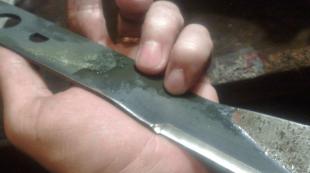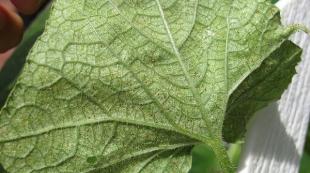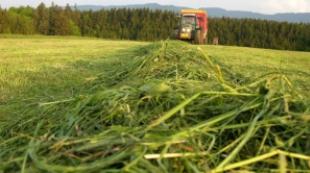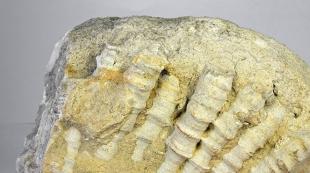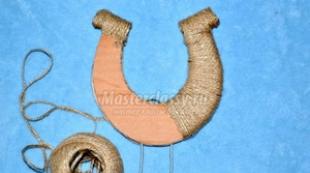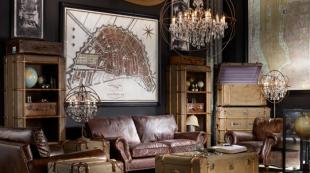The better to plaster the fireplace wall of the stove. What is heat-resistant plaster for stoves and fireplaces - types of refractory mixtures. Typical problems and defects
Today, there are a large number of diverse and dissimilar finishing materials that are used for facing fireplace stoves and portals, while each coating differs not only in its individual appearance, but also in characteristics and cost.

Stucco for stoves and fireplaces is one of the most suitable and frequently used options, the main advantage of which is budget. However, do not forget that the plaster must be able to be applied correctly, so that subsequently various cracks and peelings do not begin to form on the fireplace stove. In order to do everything as correctly and professionally as possible, you need to use the tips, instructions and recommendations that you can find in this article, as well as follow a clear sequence of these actions.
Composition and division
Plastering a fireplace is a rather complicated and ambiguous process in which it is necessary to apply all available skills, knowledge and not try to do everything faster, not run ahead and not violate the stages of work.
Finishing the fireplace with plaster, in turn, implies that when choosing such a material, it is necessary to choose it in strict accordance with certain qualities and characteristics. First of all, heat-resistant plaster for stoves and fireplaces must withstand high heating temperatures and rapid cooling, while such a coating will be not only decorative, but also protective.


Stucco for ovens can be mixed with your own hands, for this you will need to purchase and prepare the necessary components, it is important that they are of high quality and added strictly in the required proportion. You can also buy a ready-made mortar for plastering the surface of stoves, fireplaces, grills, barbecues and other heating units, the most popular are Pechnik and Terracotta solutions.
Plaster, with which the oven will be reliably protected, can perform not only a protective, but also a decorative function, thus you can choose the most suitable color and structure of such a coating. According to its varieties, decorative plaster can be silicone, mineral, silicate or acrylic, to create a unique and inimitable image, you can buy Venetian plaster, after applying which the surface of the fireplace will be similar to marble with a unique and interesting pattern, color differences.




Stucco for the stove, which you can buy in Moscow and any, even the smallest city, can be Finnish, the surface of the fireplace covered with such a composition will look like the most expensive natural minerals.
Plastering the oven with your own hands is only necessary after you have bought a ready-made solution and diluted it with water in the required proportion, as an option, you can use a special proportion in which you need to prepare and combine certain components. Below you can find several options and proportions of such a composition:
- Mix finishing clay 1 part and mix with 2 frequent asbestos and 2 parts sand;
- Take 2 parts of sand, 1 part of lime, 1 part of clay and 1 part of asbestos, mix everything;
- 1 part Portland cement, 2 parts sand, 1 part asbestos and 1 part clay - mix everything well until a homogeneous consistency.


A fireplace, the plaster for which is initially mixed without water, which must be added just before use, will tolerate high heating temperatures up to 900 degrees. Such refractory plaster can be even stronger if a little straw is added to it at the last stage and it is good to sift such a solution through a fine sieve, thereby eliminating all pebbles and debris.
The furnace, the brick for which is chosen exclusively of high quality, without cracks, chips, deformations, in addition, must be a refractory furnace, this is especially important if your furnace is solid fuel and you need to assemble a furnace and a chimney - areas whose heating will be maximum.
The stove, finished with decorative plaster, will not only have good protection, but also an interesting design and decoration that will bring comfort, an indescribable atmosphere and color to your home.



Plaster, the solution of which can be either bought in a specialized store or made by oneself, should be layered taking into account a number of rules and only in compliance with the necessary sequence, which will provide such a coating with durability and presentability in the future.
The mortar, the furnace with which will accumulate thermal energy well, must be refractory, plastic, thus it will be able to expand when heated to the required degree and together with brick and masonry mortar, which will not allow cracks and deformations to form. The composition of such plaster should be as environmentally friendly and natural as possible - this will allow the safe heating of the fireplace stove, in which no harmful and hazardous substances will be released into the air of the room. Clay, the stove with which it will warm up well, should, when incorporated into the composition, form a consistency that provides your fireplace stove with a good accumulation of heated air, as well as high thermal conductivity, which will ensure maximum and efficient overheating of the house.




Do-it-yourself finishing
Plastering fireplace stoves is a responsible and complex process, although at first glance everything may look a little different, before starting facing work, it is important to make sure that you have prepared all the necessary components, materials, tools, studied the instructions and stages in detail actions performed.



For work, at the first stage you will need to purchase the following tools, which are guaranteed to make your work easier:
- The tank in which you will mix the mortar and trowel;
- Sandpaper and a medium-sized brush;
- Bucket with clean running water;
- Tools for measuring flatness - building level and / or plumb.




After all the tools and materials are purchased and prepared, you need to read the work manual again and determine the stages that you plan to follow to the end.
For convenience, at the first stage you need to heat your fireplace stove for 2-5 hours, and then clean its surface (remove the old lining, wipe off dust, degrease, tidy up all the seams and joints between the bricks).
Now you need to start the main work, which is carried out strictly in stages, you can familiarize yourself with the sequence below:
- In order for the brick surface of the fireplace not to absorb a large amount of lining and at the same time the adhesion is maximum, at the first stage it is necessary to properly moisten and impregnate it with flowing clean water bricks;
- Now we start applying the so-called base or the first layer of plaster, for this, using a special device, we apply it with a thin layer on the brick surface and evenly level it. The thickness of the feather base layer of plaster should not be more than 4-5 millimeters;
- Now we proceed to priming the surface of the brick fireplace stove, for this we use a special heat-resistant primer, which is specially designed for these purposes. The thickness of the second applied primer layer should also be optimal and small, about 4-6 millimeters, it is necessary to apply the second layer with high quality, while distributing it over the entire brick surface, rubbing every seam, brick and thereby eliminating all previous irregularities and flaws. The second layer must fit snugly to the surface, while its consistency will be more liquid than the first main one, so that your grout does not dry out immediately, the fireplace surface must be periodically moistened by applying water;
- The third layer is the latest in application, and how well it will be applied and distributed over the surface depends on which appearance will be at the final lining of the furnace. By its consistency, the third and final layer will be even more liquid than the second, it is also evenly distributed after application over the entire surface of your brick heating unit. In order for you to end up with a perfectly flat and sealed surface, make sure that at the last stage, your solution fills all the remaining cracks, voids, and irregularities.



In the end, subject to all the tips, rules, norms and recommendations, your layer of plaster, made in three stages, will be about 1.3-1.6 centimeters thick, but not more than 1.7 centimeters. Since in this case cracks and chips may begin to form on the surface, for thick lining, a special fine-mesh reinforced mesh is often used and fixed on a brick surface, which securely fixes any material and prevents it from crumbling and cracking in the future.
Also, if necessary, you can perform the design of such a cladding various materials and other compositions, for example, you can apply a certain pattern, pattern or ornament to the surface of the fireplace using acrylic or any other refractory paint. You can do this both with your own hands and with the help of special stencils that can guarantee you the best result, you can also assemble various decorative elements, shelves, boxes, countertops, firewood with your own hands.


You can additionally design and decorate your fireplace by using not only plaster or paint for its lining, but also other refractory components, such as natural and artificial stone, ceramic tiles, tempered glass and metal.
Plaster for fireplaces and stoves is a versatile product, as with its help you can decorate not only a fireplace in a classic style, but also in the most unusual styles, ranging from modern and high-tech to Provence, country, loft, art pop , gothic, minimalism.


An interesting use of decorative plaster for finishing and lining fireplace stoves with your own hands is proposed in this article, namely, imitation of brickwork:
A fireplace, designed in compliance with all basic rules and building codes, will give its owners warmth and decorate the interior of their homes for many years. However, in order for the fireplace to be truly beautiful and fit well into the surrounding space, it is necessary to complete its finishing.
The existing options for finishing private fireplaces are so diverse that you can easily choose a decor option that fits perfectly into the interior without any problems.


After the completion of the laying of the fireplace, the seams must be grouted. In accordance with the technology, the solution is distributed between the masonry elements using a special curly tool. The seams can be made indented or convex at the choice of the owner.
Also, the seams can be filled with a solution with pigments of the desired color. The finished design will look quite beautiful and original.

Start processing with the design of horizontal seams. Clean the dried solution with a brush made of natural materials. It is better not to use tools with wire bristles for such processing - it is too rough.
Finally, coat the masonry with a special heat-resistant paint and varnish composition of your choice.

Painted brick fireplace
Stucco finish
The easiest to perform and one of the most budgetary methods of finishing a fireplace, which is widely popular.
Plaster allows you to create a wide variety of decorative effects. For example, you can apply finishing plaster with a sponge or a special rubber spatula, which will create an attractive “ripple” effect. To enhance the result, the solution can be slightly tinted with water-based or lime-based paint.
Let the erected brick fireplace dry completely and proceed with the plastering.
Video - Plastering the fireplace
First step
Add fiberglass, previously cut into small pieces, and salt to the composition of the plaster mixture. Such additives will help improve the quality of the coating.

Second step
Clean the surface of the fireplace and close the seams to about a centimeter deep. It is best to keep the fireplace a little warm, so you will need to heat it before you start plastering.

Third step
Slightly dampen the fireplace and start applying the first coat of plaster using the "spray" method.
Fourth step


Venetian - fireplace decor
After the first layer of finish has completely dried, proceed to applying the finishing plaster. To do this, use a trowel or brush. Level the applied coating with a grater.
The thickness of the final layer of plaster should be no more than 0.5 cm. Level the coating in a circular motion. The surface can be lightly sprinkled with water if needed.


Fireplace decoration - vine molding and decorative plaster
The fastening of the material is carried out traditionally on a pre-equipped frame. In the process of fastening the vertical frame racks, make sure that in the future the joints of the sheets are as accurate as possible.



The connection of plates can be carried out exclusively on frame elements. Attaching sheets between profiles is prohibited.

First step
Apply marks on the mounting surfaces to fix the profiles. Check that the markup is done smoothly and on the same level.

Second step
Fasten the racks of the frame in accordance with the markup. Fix the profiles with screws.
Third step
Mount horizontal frame elements between vertical posts.

Fourth step
Start framing the frame. Use self-tapping screws to fix drywall. Place fasteners every 150 mm.
Fifth step
Seal the joints with tape, pre-moistened with a solution of gypsum.
sixth step
Secure the corners of the structure with metal corners.

In conclusion, you just have to plaster the finished cladding. To do this, use the instructions above. You can also decorate drywall with other suitable material.

Do you want your fireplace to look truly elegant and chic? Then pay attention to the finish with the use of stone. Natural facing stone is characterized by excellent performance characteristics and fits perfectly into any interior.
If you have access to specialized equipment, you can independently perform the preliminary processing and installation of marble or granite. In the absence of the necessary devices, give preference to shell rocks, limestone and rubble stone.


The artificial stone externally does not have noticeable differences from the natural finishing material. It can also be safely used to decorate the fireplace.

Artificial stone can be made by hand. To do this, mix cement, sifted sand and coloring pigments of the desired color and pour the resulting composition into silicone molds. Let the solution in the molds harden, remove the resulting products and use them to decorate the fireplace.


The cladding itself is carried out in the same way both in the case of natural stone and when using an artificial analogue. It is enough just to fix the elements on the surface of the fireplace with mastic or tile glue. You can first lay out the stones on the floor to see the future finish and choose the best option for placing stones directly on the surface of the fireplace.

This cladding belongs to the category of the most popular options for finishing fireplaces. For finishing, the following materials are best suited:

All mentioned materials are characterized by excellent wear resistance, resistance to high temperatures and mechanical damage.

When choosing a finishing finishing material, be sure to pay attention to the size of the elements. Large tiles are much easier and faster to install, but they will be difficult to fit under shelves, ledges and all kinds of niches. With small tiles, such problems will not arise, but you will spend more time laying them.

It is also important to choose the right adhesive mixture for tile installation. Use only heat-resistant compounds made with elastic substances. Due to the elastic structure, the adhesive will not deform when the temperature rises.
First step
Prepare the fireplace for tiling. To do this, clean and deepen the seams. If there is any old coating on the fireplace, remove it.
If desired, a coating such as paint and plaster can be left by stretching a metal mesh over it with a mesh size of up to 150x150 mm. Fasten the mesh with self-tapping screws or nails.

Second step
Level the base with glue. Let the applied mixture absorb well and dry.
Third step
Mark the surface for finishing and get to work. Start fixing the tiles from the bottom row of the fireplace.
The sequence of work: using a notched trowel, glue is applied to the back of the tile, the element is firmly applied to the base and gently tapped with a rubber mallet.
To ensure that the seams between the tiles are the same size, use special plastic crosses, installing 2 pcs. on each horizontal and vertical side of the cladding element.

Immediately after finishing the finishing work, remove the remaining glue, because. it is extremely difficult to scrape it off after drying.
Leave the finish to dry for about a day, and then rub the seams. For this treatment, use a pasty mineral grout. The basis of this tool is cement. Fill the joints with grout and smooth them out carefully with a damp sponge.
Leave the grout to dry for about a day. In conclusion, you will only have to process the filled seams with a special dirt-repellent agent.
Tiling

A fireplace with such a lining has a very original, beautiful and unusual appearance. For finishing, you can use glossy and matte tiles, with a relief surface or some kind of pattern.


The main difference between a tile and an ordinary tile is the presence of a special box-shaped protrusion, known as a rump, at the first.

This element allows you to fasten the tiles to the surface of the structure. In addition, the tillers accumulate heat in the process of burning the fireplace, which contributes to some improvement in the heat transfer of the unit.

First step
Prepare finishing material. Examine the tiles carefully. Even samples belonging to the same batch may have a slightly different shade. Arrange the tiles so that the finished finish looks as uniform and harmonious as possible.

Second step
Adjust the cladding pieces to the same size. To do this, use the grinder.
Third step
Proceed to fixing the tiles. The elements are fixed using wire.

Fill the tiller of the tile with a mixture of brick fragments and clay to 50% of the volume. Insert a piece of metal wire into the tiller. Traditionally, a rod with a diameter of 0.5 cm is used. In this case, the segment must be placed with a slight upward bend.
Tie a soft wire to the middle of the installed rod. Fill the tiller with the previously mentioned mixture to the full volume.

Lay the tile, press it firmly against the surface and hide the soft wire in the masonry joint.
To connect the tiles to each other, use U-brackets.
wood finish

Natural wood is perfect for finishing the fireplace. The breed can be any, because. special modern impregnations make it possible to give wood the appearance of even the most valuable species, but it is better to use high-quality, durable and strong material.
Wood is used to decorate the fireplace portal. Shelves are also made from this material.

Previously, the wood must be impregnated with a flame retardant to increase the refractory properties. Finally, the design can be painted and varnished.
Successful work!
Video - Do-it-yourself fireplace decoration
On modern market a huge range of heating appliances and hobs of various configurations and designs is presented. Despite this, a person is not ready to give up the natural beauty of fire and its magical warmth that warms the soul.
Fireplaces and decorative stoves with an exquisite and high-quality finish will not only be a decor item, but will also bring coziness and comfort to the house.
For finishing, you can use both classic plaster compositions and ready-made specialized mixtures, which are sold in every building materials store.
Stucco for stoves and fireplaces must be heat-resistant, and also different high level coupling with the base and not lose their properties from temperature changes, namely heating.

Plastering Fireplaces: Reasons and Benefits
Heating devices that are built of brick are recommended to be coated with a special mixture. Plaster solves several problems and design flaws:
- improving the appearance of the heat source, the accuracy of the design;
- providing a reliable sealed layer that prevents carbon monoxide from entering through cracks between bricks in the event of surface cracking;
- ensuring the purity of the structure, namely protection from the appearance of harmful microorganisms between the seams.

Ready mixes for plastering
Before choosing a finishing material, it should be remembered that it must protect the surface and be resistant to high temperatures. Therefore, it is better to give preference to ready-made compositions that are sold in building materials stores.
- ORTNER is a specialized mixture for decorative finishing of stoves and fireplaces.
- Plitonite-SuperFireplaceFireproof is a composition that has a high level of heat resistance and plasticity, and also contributes to the integrity of the outer coating. It is characterized by the presence of heat-resistant fibers and additional adhesive ingredients. The building material remains pliable, remains plastic for half an hour.
- Rath Hefnerputs is a top coat that retains its integrity when heated up to 200°C. The presence of liquid glass makes the mixture more plastic and resistant to external factors, prevents the formation of cracks. Heat-resistant plaster for finishing stoves and fireplaces - "Pechnik" and "Terracotta".
Application and grouting of decorative plaster Lamb
Do-it-yourself mixtures
If you decide to save money, you can prepare the material for plastering the surface yourself. The main components are: clay, cement, sand, lime, asbestos. To increase strength, you can add burlap, fiberglass, natural fabric fibers. Such additives reinforce the plaster layer.
- The simplest and least expensive combination is clay and sand. To obtain a mixture, mix clay and sifted sand in a ratio of 1: 1 and 5% of total weight ground asbestos. The consistency of the mixture should be similar to batter. The application process will be much easier, and the material will fill the smallest cracks, if any. This version of the plaster has negative characteristics: low strength. To avoid the appearance of cracks, the material should be improved and slaked lime should be added.
- An alternative is the composition of clay and sand in a ratio of 1:1. To increase heat resistance, it is necessary to optimize the plaster with asbestos powder and two parts of high-quality cement.
Tools

For the plastering process, you must first prepare the necessary tool:
- trowel;
- spatulas;
- brushes;
- grater;
- chisel, metal brushes;
- plumb, level, rule.
Applying plaster
Before applying the mixture, you should heat the stove or fireplace, heat it up, despite the season and the temperature outside the window. It is necessary to remove the remains of excess building materials and dust, clean the surface, prepare for plastering. A high-quality coating also depends on the performance of the seams between the bricks.
Using a brush, it is recommended to moisten the walls of the fireplace or stove and cover with liquid clay mortar. Reinforcement is used for optimal strength of plaster. To do this, you need to paste over the walls with pieces of burlap. Plastic plaster is applied on top.
The layer thickness should not exceed more than 1 cm. The maximum allowable layer of the mixture is 5 cm. When the material dries, the coating must be rubbed with a special grater. This technique helps to neutralize even the smallest cracks.

Before using the fireplace or stove, make sure that the applied layer of plaster is completely dry.
The selected material for finishing fireplaces and stoves is the key to success in construction work this category. Compliance and compliance with the stages of work on applying the composition will also ensure long-term operation and high-quality results.
Video: Stucco ovens
When you create a fireplace or stove, you should choose not only the project, but also facing materials, solutions. It is worth determining which chimney you will use, which backing brick you will use. In the construction of a stove or fireplace, a cladding mortar is directly involved, since stoves that have not been clad are usually not particularly aesthetic in appearance. Over time, dust accumulates in the seams of the stove masonry; when the stove or fireplace is heated to high temperatures, this dust causes not the most pleasant odors. You can prevent such unpleasant phenomena by plastering or cladding with decorative ceramic tiles, tiles, glazed tiles.
Components that make up the solutions for the plastering procedure.
The composition of solutions for furnaces can include a wide variety of substances. To cover the oven, you can use one of the simple solutions:
- cement-clay sand,
- lime-gypsum,
- lime-clay sand.
For the procedure, you can use both a ready-made solution and prepared by yourself.
What dry mixes for plaster are better?
Most often, the plastering procedure takes place using clay.
Usually, for the procedure of plastering the front surfaces, they wait until the moment when the bricks become completely solid, because then the possibility of subsequent shrinkage is excluded. The oven is guaranteed to serve you for a long time if you properly prepare the composition for the procedure.
In order to prepare a solution with clay, it must be soaked in water for one day in order to absorb water into it. Before this, the sand is carefully sieved, and the mass prepared from a mixture of water, sand and clay is mixed with the help of a mixer nozzle until a homogeneous mass is formed.
The amount of sand needed depends on the fat content of the clay. If it is high, then the proportion of the ingredients of the mixture will be one part to three parts or one part to four parts. To increase the strength of the plaster, glass or asbestos fiber is used.
It should be noted that the quality of the prepared mixture for plastering is determined by the ease of applying it to the surface and the degree of its smoothness during leveling.
Technique for the correct application of plaster
Before starting work, it is necessary to clean the stove or fireplace from possible contamination, as well as dust and residues of the mortar used for masonry.

To increase the adhesion of the mortar and the surface to be plastered, it is necessary to clear the seams to a depth of about half a centimeter before work. Before lining, the furnace must be heated so that the work is carried out and, accordingly, the solution is applied to the heated walls.
In order to prepare the plaster for the surface, it is necessary to mix the following ingredients in one of the proportions presented:
- For two parts of sand, 1 part of clay and 0.1 part of asbestos is taken.
- For 2 parts of sand, 1 part of cement, 1 part of clay and 0.1 part of asbestos are taken.
- For 2 parts of sand, 1 part of lime, 1 part of clay, 0.1 part of asbestos is taken
- For 2 parts of lime, one part of gypsum and sand is taken, and 0.2 parts of asbestos are taken
- For 2 parts of lime, you need to take 1 part of gypsum, 1 part of sand and 0.2 parts of fiberglass.
Asbestos materials are very toxic, therefore it is necessary to avoid their use in mixtures for plastering both at the masonry stage and during repairs. Following the manufacture of the mixture for plastering, the stage of direct lining of the furnace follows. It is recommended to start plastering from the top of the furnace being designed.
For proper plastering, you need to know one small but important detail. Before applying the mixture to the brick, it should be wetted with water.
- First, a liquid is applied, followed by a thick layer of facing mixture.
- For proper application of plaster, tools such as a float and trowel must be used.
- To avoid uneven drying of the plaster, it is necessary to apply the mixture in uniform layers no more than half a centimeter thick.
- When the topmost layer of the lining has set, but has not yet lost its softness, you need to rub it with a wooden grater in a circular motion.
- As a result, you should get a flat and smooth surface.
- If the plaster has already set and is poorly rubbed, it is necessary to slightly moisten it with water using a brush or a large brush.
- Avoid exceeding the thickness of the plaster layer above ten millimeters.
- Stucco is applied to the corners of stoves in the same way as to openings in windows and doors.
- To carry out this procedure, it is necessary to set the rails made of metal or iron according to the level and shape of the well-known letter G.
- Ten minutes after applying the solution, the rail must be carefully removed.
- Adjust the angle if necessary.
- Then grind it with a grater.
An alternative for preparing the mixture on your own is a dry mix for plastering ovens. If you are laying a firebox using chamonite bricks or building stoves, then you need to use a clay mortar, another name for which is a refractory mixture for stoves. Such a mixture fully justifies its name, as it can provide normal performance at temperatures of about 1200 degrees.

If you decide to use a brick for the lining procedure, then the plaster, which has the property of heat resistance, is guaranteed to increase the reliability of the entire furnace. After all, the temperature at which it can be safely used is approximately equal to 800 degrees Celsius.
Professional secrets of excellent cladding
We list the reasons due to which the plaster of the furnace can begin the peeling process:
- Inappropriate seam thickness.
- Rows of used bricks are not tied correctly.
- The oven has overheated.
To prevent such a problem, it is necessary to cover the oven with burlap before the lining procedure. Previously, the material is soaked in clay diluted to a liquid state, and the furnace surface is thinly covered with clay mortar. A straightened piece of burlap is placed on the stove so that layers of air do not form. Care must be taken to ensure that the oven does not get too hot.
Instead of burlap, it is allowed to use a thin steel reinforcing mesh. The cell size of such a grid should be no more than one centimeter. To attach the mesh to the brick, it is customary to use a wire with a thickness of 0.3 cm. It must be taken into account that the wire is inserted into each of the rows of masonry even at the construction stage. When the solution for plastering the oven is completely hardened, the oven is covered with lime milk (with the addition of salt in the amount of one hundred grams per bucket). Staining of the furnace is carried out using chalk on milk from lime.
It must be remembered that oil paints cannot be used to paint the oven, since at high temperatures the decomposition process begins in them, and the drying oil burns.
Indicators of excellent cladding
After the completion of the lining of the stove or fireplace, you should expect results that will show that the work was successful. Here are the results:
- The vertical plane along the entire height of the furnace should not deviate by more than 1 centimeter.
- The horizontal plane along the entire length of the stove or fireplace should not deviate by more than 2 centimeters.
- The rod between the corners should not deviate from a straight line by more than 0.3 cm.
- When imposing a two-meter rule, the differences from a flat plane should not be more than 0.2 centimeters deep.
What to do if the oven is not plastered?
If you have decided not to carry out plastering work, then you will need to arrange masonry. In this case, it is better for you to use a brick for cladding. The best option for decorating the walls of a stove or fireplace is to decorate with bricks with a leveled surface. When using such a brick, the laying must be carried out very carefully, and the seams will need to be embroidered.
For embroidery for decoration purposes, a special concave-shaped device and an ordinary solution are used. For greater decoration, the corners of the stove are edging, cut off diagonally and thus give an elegant look to the entire stove or fireplace. The same operations are possible for the oven plastering process.
When jointing in color, the choice of bricks is carried out in accordance with uniformity and coloring. On the front surface of the fireplace or stove, the seams remain unfilled by 10 millimeters. With the help of a wet piece of cloth, the masonry is wiped, and polishing is also carried out with a piece of brick. In this case, it is necessary to smooth out all inconsistencies.
Using gloves, use your hand to rub white cement mixed with asbestos flour and water into the seams. The aesthetic characteristics of such decorative masonry depend on the accuracy and straightness of the seam lines, so the embroidery is carried out in accordance with certain rules. First you need to fill the vertically located seams, then the seams that are located horizontally. In the case when embroidery of different colors is needed, various pigments are added to the solution.
Features of the construction of fireplaces
A fireplace is not such a heat-intensive device in comparison with a stove. After all, the stove accumulates heat inside itself, and the fireplace radiates heat into the room itself, thus heating it. The fireplace gives off heat while the wood is in the burning stage, at which time only a small part of all heat accumulates in the walls. Typically, fireplaces are installed in country houses, less often in city apartments.
Usually, installing fireplaces in urban areas causes some difficulties and the need to draw up appropriate documentation. Installing a fireplace is a laborious and expensive job. This happens due to the fact that you need to meet all the requirements that various services impose. Difficulties may be caused by the need to redevelop the apartment. In this case, the location of the fireplace and chimney can be moved. Difficulties can also be caused by the design features of the house where the installation is made, the ability to withstand the weight of the installed fireplace. In case of non-compliance with the requirements, it will be necessary to create a base that will be strong enough for the fireplace and chimney, or “simply” strengthen the floors between floors.
- This mixture is an environmentally friendly material. It does not contain toxic substances, so it does not threaten the health of households.
- Finishing with decorative plaster with heat-resistant properties lasts for many years and does not require special care.
- A mixture for plastering stoves and fireplaces can be used in rooms where there is a high percentage of humidity. The fact is that it has the ability to not absorb moisture.
- Due to the many features of the plaster, the work can be done independently without the involvement of specialists who will need to pay a considerable amount for help.
- The solution can be painted in any color. To do this, you need to add the desired dye during its preparation. During operation, you can always repaint the coating in a different color.
Advice. Decorative plaster for stoves and fireplaces is applied to almost any material. However, you need to choose the right mixture.
There are several types of decorative plasters designed for finishing the fireplace. You need to choose the one that works best for your case. At the same time, it is necessary to take into account the location of the object and in what conditions it will work. Therefore, it is necessary to pay attention to the composition of the material, and to the features of its application.
Types of plasters
- Mineral decorative plaster. It is created on a cement base and is the most economical option for finishing stoves and fireplaces. It withstands high temperatures well, as well as their sudden changes. She has a long service life, but provided that the fireplace is in a room without constant heating.
- acrylic blend. It consists of acrylic and mineral elements. The surface finished with this plaster can withstand temperatures of almost 90 degrees. Therefore, such a mixture can be safely used for any design.
- Silicate plaster is based on liquid glass. It has a vapor permeability that is much better than that of the above materials. The cost of such decorative plaster is quite high.
- Silicone decorative plaster for the fireplace contains silicone resins. Therefore, it repels water well, and also has an antistatic property.
Having chosen the necessary material and having prepared all the tools, you can begin work. The process of plastering the fireplace with a decorative mixture is carried out in accordance with the rules in stages.
Advice. When decorating stoves and fireplaces, do not neglect any of the steps and do the work according to technology.
Surface preparation
Decorative fireplace plastering begins with surface preparation. The better you prepare the plane, the more beautiful the appearance and quality of the product will be. Otherwise, the coverage will not please you for a long time.
.jpg)
The first step is to clean the stove or fireplace from the old coating. This operation can be done with a metal brush, and the old plaster should be beaten off with a hammer.
Now we clean the seams deep into 1 centimeter. This is necessary so that the material adheres well to the base. After complete cleaning of the surface, apply a primer mixture to it.
Advice. For better adhesion between materials, a deep penetration primer should be used. Sometimes the walls are processed up to two times.
If the surface of the furnace has significant irregularities, it is necessary to use a reinforcing mesh. To install the grid on a plane, it is necessary to drive nails between brickwork. If the base is made of durable material, you should make holes with a puncher and screw in the screws. Then we begin to cling the reinforcing mesh to the nails, and this operation is carried out from the bottom up. Also pay attention to the fact that there is a small space between the surface and the grid, which will be filled with mortar.
Important. To fix the plaster mesh on the surface of the stove or fireplace, it is not recommended to use metal and plastic self-tapping screws. At high temperatures, the plastic product will melt, and the metal will begin to change shape over time and destroy the seam.
Now it's time to prepare the solution. Decorative plaster for the stove and fireplace is available as a dry mix. Each package with the mixture is accompanied by instructions that indicate how to properly prepare the solution.
Advice. It is better to sift the dry decorative mixture for the fireplace through a sieve before kneading. Then the mixture will be cleared of possible debris and coarse elements.
We place the powder in a container, and pour water into it, constantly stirring the contents. The ratio of dry mix and water is indicated in the attached recommendation. To bring the solution to perfect uniformity, it is necessary to use a drill with a special nozzle. The finished mixture should be the consistency of sour cream.
Fireplace plastering procedure
On the surface with the reinforcing mesh installed, we apply the first layer of mortar, the thickness of which should be 3-5 mm. and no more. The application of the base layer of plaster does not provide for a perfect leveling of the plane.
.jpg)
At this stage, special overlays must be applied to the corners. They must be made of steel. Since the working furnace has a high temperature, the corner plates made of another material simply cannot withstand it and begin to melt. As a result, deformation of the entire structure will occur. After applying this layer of the mixture, it is necessary to dry it for 2-4 hours.
At the second stage of the procedure, we apply the composition to completely level the plane. At the same time, you need to try to make the layer not very thick. Otherwise, the structure will dry for a long time and this may adversely affect its finish. At the second stage, we especially carefully close up the corners, trying to round them carefully.
Now we leave the fireplace for a while until the plaster is completely dry. If cracks appear during drying, there is no need to be afraid. This is easy to fix: we open the cracks with a knife, sprinkle water on them, and then rub them with the same plaster mixture. Now you can apply decorative plaster with any texture that you have chosen in the store.


